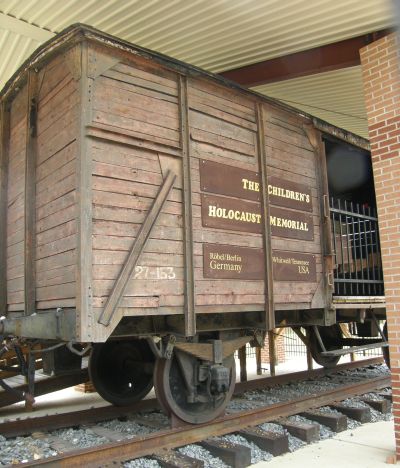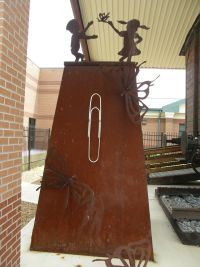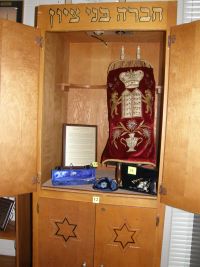6 JUNE 2011
YOUR WORDS
Readers are invited to add their comments to any story. Click on the article to see and add.
BTN DISTRIBUTION
BTN also goes out by email every Sunday night at midnight (UK time). To view this edition click here.
The Business Travel News
PO Box 758
Edgware HA8 4QF
United Kingdom
info@btnews.co.uk
© 2022 Business Travel News Ltd.
Article from BTNews 6 JUNE 2011
ON TOUR: The Children’s Holocaust ‘Paperclip’ Memorial Museum
 Whitwell Middle School Tennessee is the home of a remarkable project that from a small beginning has helped to educate a whole generation of children, worldwide. Within its “Middle America” school confines is the Children’s Holocaust ‘Paperclip’ Memorial Museum.
Whitwell Middle School Tennessee is the home of a remarkable project that from a small beginning has helped to educate a whole generation of children, worldwide. Within its “Middle America” school confines is the Children’s Holocaust ‘Paperclip’ Memorial Museum.
In 1998 Whitwell Middle School Principal Linda M. Hooper asked teacher Sandra Roberts to begin a Holocaust Education initiative that would be the basis for teaching tolerance in a voluntary after-school programme. Ms Roberts held the first class later that year. Soon the students were overwhelmed with the massive scale of the Holocaust and asked Mrs Hooper if they could collect something to represent the Jewish lives that were exterminated by the Nazis. It was difficult for them to comprehend what six million really meant. In fact 11 million is the figure now quoted to include the other victims of the Nazis.
 Through the internet they discovered that during World War II the Norwegians had taken to wearing paperclips on their lapels as a silent protest against Nazi occupation. Collecting a target of six million paperclips seemed a way to symbolise the scale of the crime.
Through the internet they discovered that during World War II the Norwegians had taken to wearing paperclips on their lapels as a silent protest against Nazi occupation. Collecting a target of six million paperclips seemed a way to symbolise the scale of the crime.
At first the project went slowly, as it did not gain much publicity. Students created a website and sent out letters to friends, family and celebrities. The project began to snowball after it received attention from Peter and Dagmar Schroeder, journalists who were born in Germany during World War II and covered the White House for German newspapers. They published some articles as well as a book, Das Büroklammer-Projekt (The Paper Clip Project) that promoted the project in Germany. The big break in the US came with an article in the Washington Post.
Almost all observers note the much unexpected location of the project. The small rural town of Whitwell has about 1,600 residents, and according to the US census, 97.35% of them white. There was not a single Jewish person among the 425 students when the project began. There were only five African Americans and one Hispanic. A hundred miles from Whitwell, in Pulaski, Tennessee, the infamous Ku Klux Klan was reportedly born.
Whitwell is tiny (in fact a village by English standards) and trying to reinvent itself after the last coal  mine, the major local industry, was shut down in 1997. About a half of the students at the Middle School qualify for the free lunch programme, an indication of hard times.
mine, the major local industry, was shut down in 1997. About a half of the students at the Middle School qualify for the free lunch programme, an indication of hard times.
The paper clips began to arrive by mail; masses and masses of them. To date 31m. Celebrities sent them including George W. Bush, Bill Clinton, Bill Cosby, Steven Spielberg and Tom Hanks. 30,000 letters have arrived, all of them responded to.
The centre piece of the museum is a genuine former German rail car which was used to transport Jews to the camps. Up to 150 people would be forced into such a wagon and then moved from all over Europe to the death camps. This particular unit was discovered in Poland and donated to Whitwell. Getting it from Germany to Tennessee was an involved effort achieved through much generosity and the help of various agencies.
The railcar is filled with 11m paper clips (6m for murdered Jews and 5m for Gypsies, Catholics, homosexuals, Jehovah's Witnesses, and other groups). The monument was uncovered on the anniversary of the Kristallnacht, 9 November 2001.
Embedded in concrete around the railcar are 18 butterflies sculptured of twisted copper. Butterflies came from a poem written by a child who lived in Terezin concentration camp in 1942 (I Never Saw Another Butterfly) and the number 18 in Hebrew symbolizes life (in Gematria 18 is the numerical value of the word çé, pronounced Chai, meaning life). Inside the truck, besides the paper clips, there are the Schroeders’ book and a suitcase filled with letters of apology to Anne Frank by a class of German schoolchildren.
There is an outstanding documentary film about the project.
 Joe Fab of The Johnson Group, who eventually became the producer, director, and writer, initially started to think about making a movie. However, it looked more like a story for a TV documentary. He filmed as several Holocaust survivors from New York who visited the school and shared their experiences with the community. Out of this footage, he made a raw seven-minute presentation. This "demo" helped to convince the Miramax film company that this project was worth a full-length movie. It was described as not yet another movie showing the tragedy, but a project of hope and inspiration. Released in 2004 it has won many awards.
Joe Fab of The Johnson Group, who eventually became the producer, director, and writer, initially started to think about making a movie. However, it looked more like a story for a TV documentary. He filmed as several Holocaust survivors from New York who visited the school and shared their experiences with the community. Out of this footage, he made a raw seven-minute presentation. This "demo" helped to convince the Miramax film company that this project was worth a full-length movie. It was described as not yet another movie showing the tragedy, but a project of hope and inspiration. Released in 2004 it has won many awards.
The Children’s Holocaust ‘Paperclip’ Memorial Museum is 160 miles north of Hartsfield-Jackson Atlanta International Airport half way to Nashville and not far from Chattanooga. It is an easy drive starting out through the centre of Atlanta and via some of the loveliest countryside Georgia has to offer. It is easy to fit into a touring holiday to include the Blue Ridge Mountains and Nantahala National Park. You are also in real Confederation Country, with it the history and places of the American Civil War. Atlanta was the home town of Martin Luther King and also of Coco Cola. Nashville means country and western music and the Grand Ole Opry. Once outside the cities your dollar will go a long way. www.whitwellmiddleschool.org
OUR READERS' FINEST WORDS (All times and dates are GMT)
All comments are filtered to exclude any excesses but the Editor does not have to agree with what is being said. 100 words maximum
